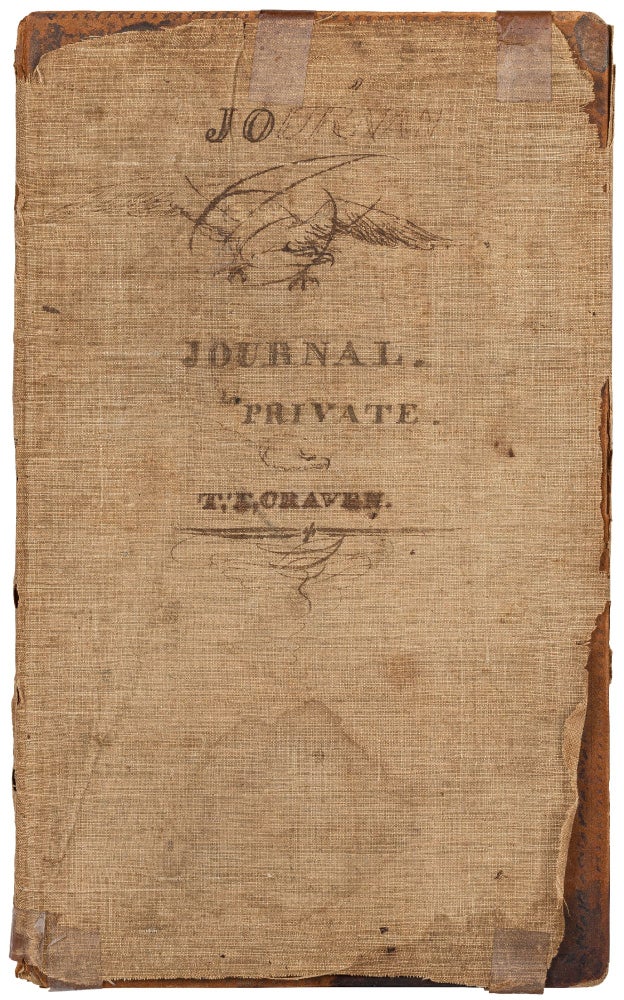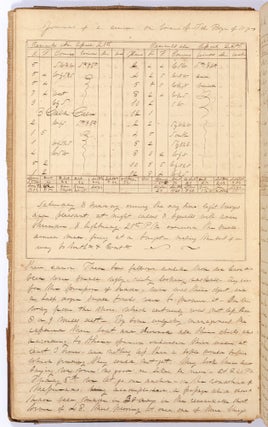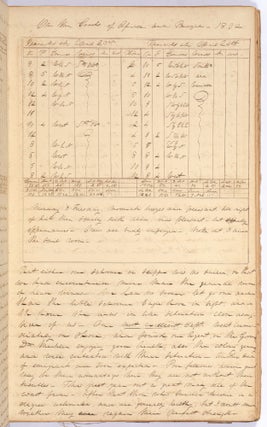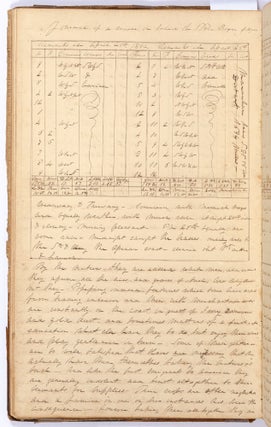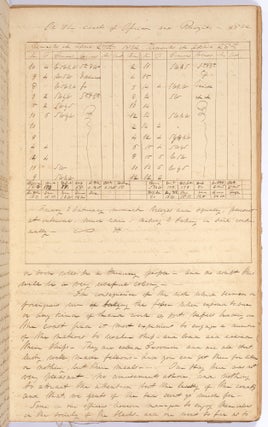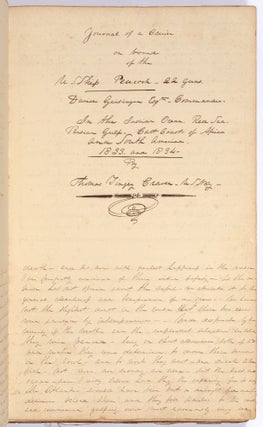1832-34.
Sold
Hardcover. A remarkable naval journal and narrative travel diary, notable for its detailed account of a three-year voyage on board two different U.S. Navy ships dispatched to suppress piracy and police the illegal transatlantic slave trade off the coast of West Africa and Brazil, and to negotiate commercial treaties in Asia and the Near East. The journal was kept by Lt. Thomas Craven, who went on to command the flagship of Captain Wilkes’s Antarctic exploring expedition in 1838, and retired a Rear Admiral after the Civil War.
Ledger size folio (8” x 13”) consisting of about 270 manuscript pages, bound in original calf over boards with a contemporary tattered sailcloth covering illustrated with a pen and ink vignette and title on the front cover. The calf is well-worn with most of the spine back lacking; front cover held in place by the sewing bands; several gatherings are shaken or detached with light tearing along a few sewing bands, else all complete and in good or better condition overall with a few small pieces of later tape to secure the sailcloth covering. Housed in a professionally made cloth clamshell box with two gilt-stamped morocco labels on the spine and top panel.
Not only did Lt. Craven keep a standard log of the cruise, recording the ship’s course, sail changes, ports of call and notable events involving the ship’s crew; but more importantly, written underneath each day’s tabular entry he kept a private narrative account of his personal experiences and reflections – totaling about 50,000 words – to be presented to his wife upon his return.
Setting off from Boston in February, 1832, the 10-gun U.S. Schooner *Boxer* first went to Monrovia, Liberia, to assess the physical and fiscal health of the colony of formerly enslaved Americans, and to furnish it with munitions and supplies. Colonist had been arriving in Liberia for just over a decade by this time but it would still be another 15 years before they would form a government and declare themselves an independent state.
Continuing its mission to support U.S. commerce in the South Atlantic, the *Boxer* went to Brazil, where it was ordered to join up with the sloop of war *Peacock* on its diplomatic missions to Asia and the Near East. Craven was sailing on board the *Peacock* during Edmund Roberts’ celebrated 1833 treaty mission to the courts of Mocha (Yemen) and Muscat (Oman), and gives an important first-hand account of Muscat’s slave market, which he describes as an open market trafficking in girls and young women.
A few short excerpts from the journal follow:
April, 1832: U.S. *Boxer* at Monrovia, Cape Mesurado (Liberia):
“Our … Capt. went immediately on shore, and found our Agent, or the Governor Dr. Mechlin enjoying good health, also the colony generally and well contented with their liberation – Another boat of emigrants are soon expected – Poor fellows, however great may be their advantages here, they are not without their troubles. The first year out a great many die of the coast fever … By the natives they are called white men, and indeed they assume all the airs and graces of such, and why shouldn’t they – Possessing immense fortunes which some have [acquired] from trading interior and then with merchantmen who are constantly on the coast in quest of ivory, camwood, and gold dust … What else have they to do but enjoy themselves and play gentlemen in turn. Some of these gentlemen are so well satisfied that *slaves* are necessary. That they actually have them themselves, taking the natives as such …
In consequence of the risk which seamen or foreigners run of taking the fever … vessels trading on the coast find it most expedient to engage a number of the natives to water ship – and load and unload their ships – They are called Kroomen [Krumen people] and are all about, lusty, well made fellows – and you can get them for little of nothing but their meals. Our stay here was not very pleasant – no amusements ashore, and nothing to attract the attention but the beauty of the country … Some of our officers however managed to enjoy themselves in the society of the blacks – and one went so far as to take a sort of a liking to a young damsel of colour … and he a married man too. In consequence of his high standing with the father & mother I expect we may attribute the very kind and polite invitation we all received to dine one day.”
May, 1832: U.S. *Boxer* at Maranham and Para, Brazil
In May the *Boxer* sailed back across the Atlantic to Brazil at the Port of Maranham and the adjoining provinces of Para and São Luis, where Craven went ashore to dine with the American Consul in São Luis de Maranhão:
“After dinner we took another walk, and about sunset for the first time I saw a female in the street. This is a very uncommon occurrence in Brazil. Ladies are hardly ever seen walking out & in fact hardly ever seen at all … As is the custom in this country, this lady was sitting in a cotton hammock which was slung to a long bamboo pole, and borne along on the shoulders of two tremendous big Negroes – some of these hammocks are most beautifully woven … We now returned home and then met the English Consul Mr. Hesketh ... .”
Craven also gives beautifully evocative accounts of his visit to an English burial ground and private garden at São Luis, and of the *Boxer’s* passage along an interior river. At the end of August the *Boxer* sailed to Rio de Janeiro for much needed upkeep, and to pick up important dispatches to be delivered to U.S. Envoy Edmund Roberts on board the *Peacock*, which had earlier departed on the first leg of its diplomatic mission to Cochin-China (Vietnam) and Siam (Thailand).
October, 1833: U.S. *Peacock* at Muscat, Oman
The two ships finally rendezvoused in June, 1833 at “Roads of Batavia” (present-day Jakarta, Indonesia), where Craven was transferred to the *Peacock* on June 22nd for the second leg of its diplomatic mission “In the Indian Ocean, Red Sea, Persian Gulf, East Coast of Africa, and South America.”
Having arrived in Muscat Cove, Oman in October, 1833, Craven writes at length about going ashore with a few shipmates to “see what was to be seen,” including Muscat’s slave market:
“[We] arrived at the city about sunset and went to the slave market. It was in a small square, a band of policemen standing in a row through its centre. The purchasers sitting in a row against the side of a house, flat on the ground, on the opposite side of the square were the slaves of every age, men, women & children sitting on the ground against a wall. The vendors were continually walking up & down on each side of the square dragging the article to be sold by the arm calling out the price, telling their age and qualifications & recommending them to anyone who may be in want of such. The slaves generally sold [are] young Negro women, as black as jet – who are on the occasion very tastefully dressed having their faces painted, & eyebrows neatly trimmed. They appear perfectly indifferent as regards their fate, and are laughing nearly the whole time. When the buyer sees one that he thinks will answer his purposes he sings out for her and the seller takes her to him to undergo the most critical examination. If she suits she is purchased, and if no more are wanted by the one who takes her he immediately leads her off to his house. If he intends procuring more she is placed for the time being under the charge of a eunuch (of which denomination of human beings, I understand almost every gentleman is possessed of at least three or four). After seeing all that was to be seen and becoming heartily disgusted and sickened at the proceedings of these women traders we stepped into the boat and returned to the ship …”
Craven also writes a long and emotionally charged account of the life and death at sea of a young Javanese man, Richard Boa, who had joined the ship as a supernumerary hoping to visit America. The two men had become the “best of friends.” After later visits to Mozambique and Cape Town, the *Peacock* returned to Brazil in 1834, where Craven rejoined the *Boxer* at Rio de Janeiro, and returned home to Norfolk, Virginia.
Thomas Craven went on to enjoy a long and prosperous career in the Navy. In 1838 he commanded the *Vincennes*, Captain Wilkes’s flagship in the Antarctic exploring expedition and assisted Matthew C. Perry in suppressing the illegal slave trade off Africa. In 1861 he was placed in command of the *Brooklyn*, participating in the capture of New Orleans and subsequent operations on the Mississippi. He was made Commodore in July 1862, and during the subsequent years of the Civil War commanded the *Niagara* on the coast of England and France. He later assumed command of the Pacific squadron and retired, a Rear Admiral, in 1869.
An historically important first-hand account of a remarkable voyage on board two U.S. navy ships dispatched around the world to project America’s emerging economic and political power after the War of 1812.
Additional information about Craven’s voyage together with longer extracts from the journal are available.
Item #448018


